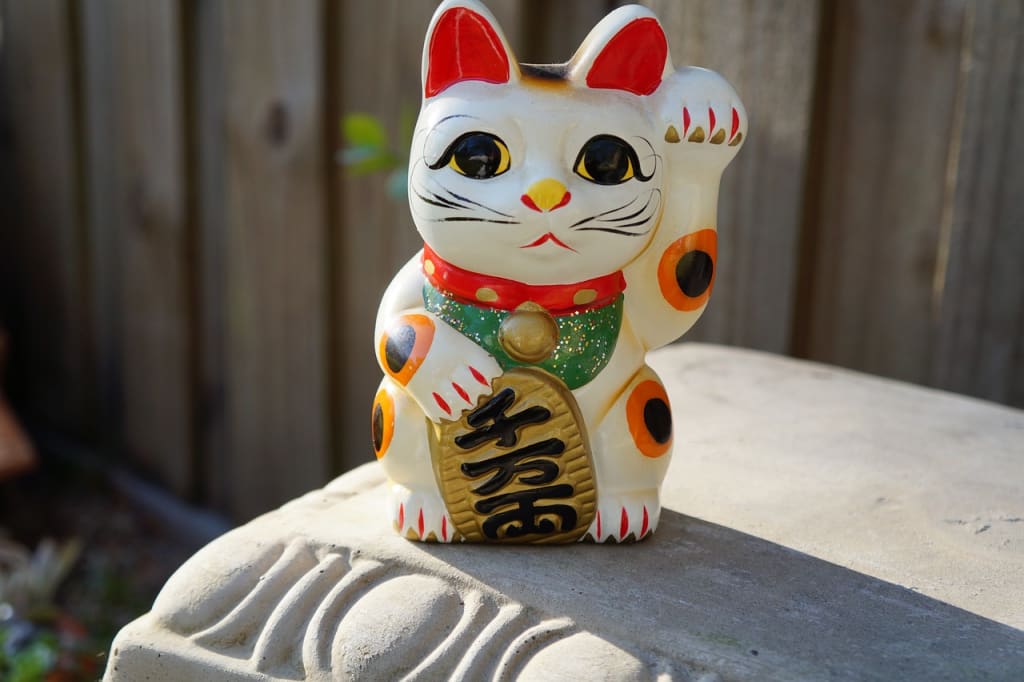The Origin of the Maneki Neko cat
The Maneki Neko, also known as the "beckoning cat

The Maneki Neko, also known as the "beckoning cat," is a popular Japanese figurine believed to bring good luck and fortune to its owner. The origin of the Maneki Neko is steeped in folklore and historical anecdotes, with several stories explaining how this charming cat became a symbol of prosperity.
Folklore and Legends
The Temple Cat
One of the most well-known legends about the Maneki Neko dates back to the Edo period (17th to 19th century) in Japan. According to the story, a poor monk lived in a small, run-down temple called Gotokuji in Tokyo. Despite his poverty, he shared his meager food with his pet cat. One day, during a storm, a wealthy feudal lord (daimyo) named Ii Naotaka was passing by the temple. Seeking shelter under a tree, he noticed the cat beckoning him into the temple by raising its paw. Curious, he followed the cat and entered the temple just as lightning struck the tree. Grateful for the cat's saving gesture, the lord became a patron of the temple, donating money to repair and expand it. Upon his death, the cat was honored, and Gotokuji Temple became a place of worship for the Maneki Neko.
The Courtesan and the Cat
Another story involves a beautiful courtesan named Usugumo, who lived in a brothel in Yoshiwara, a famous red-light district in old Tokyo. Usugumo adored her pet cat, but one night, the cat began tugging persistently at her kimono. The owner of the brothel, believing the cat to be possessed, cut off its head. The severed head flew through the air and landed on a snake about to strike, killing it and saving Usugumo's life. Devastated by the loss of her beloved pet, Usugumo was consoled by a customer who carved a wooden statue of the cat, which became the first Maneki Neko.
Historical Context
While these legends provide colorful origins, the historical context suggests that the Maneki Neko emerged during Japan's Edo period. The earliest documented reference to the Maneki Neko dates back to the late 19th century, and by the early 20th century, the figurines had become popular in households and businesses.
Design and Symbolism
The Maneki Neko typically features a cat sitting upright with one paw raised in a beckoning gesture. The raised paw can have different meanings:
Left Paw Raised: Attracts customers and people, making it popular in businesses.
Right Paw Raised: Brings wealth and good fortune, commonly seen in homes.
The color of the Maneki Neko also holds significance:
Calico: Traditional and considered the luckiest.
White: Symbolizes purity and happiness.
Gold: Represents wealth and prosperity.
Black: Wards off evil spirits.
Red: Provides protection and good health.
Modern Popularity
Today, the Maneki Neko is a ubiquitous symbol of good luck, found not only in Japan but also in Chinese and other East Asian cultures. It appears in various forms, from traditional ceramic figurines to modern-day keychains and plush toys, continuing to beckon good fortune and prosperity to those who welcome it into their lives.
The Maneki Neko, with its rich blend of folklore, historical significance, and cultural symbolism, remains a beloved and enduring figure in Japanese culture and beyond.
About the Creator
Enjoyed the story? Support the Creator.
Subscribe for free to receive all their stories in your feed. You could also pledge your support or give them a one-off tip, letting them know you appreciate their work.





Comments
There are no comments for this story
Be the first to respond and start the conversation.